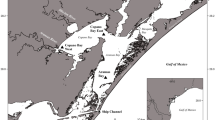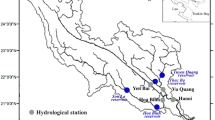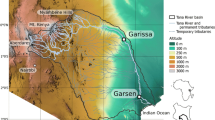Abstract
The Yangtze River basin regulated by the gigantic Three Gorges Dam (TGD) is the best location to study the impacts of intense anthropogenic modifications on the global biogeochemical cycles. However, frequent drought periods commencing from 2006 to 2011 may equally act as a strong factor influencing the particulate organic matter (POM) flux. To capture the distinctive role of TGD operations and drought severity on the POM, weekly sampling of total suspended matter (TSM) concentration was conducted at Nantong in the lower Yangtze basin. Biogeochemical parameters (POC% of TSM, PN% of TSM, C/N ratios, and δ13C), CaCO3%, mean suspended sediment size, and drought parameters (mean temperature, solar radiation, relative humidity, wind speed, evapotranspiration, and rainfall) were evaluated. The inverse power-law correlation between TSM-POC% and TSM-PN% was observed and POC% during 2008–2009 was found to be higher than pre-dam values. The δ13C and C/N range from − 25.6 to − 24.1‰ and 4.8 to 9.2, and moderate negative correlation between CaCO3-POC% and POC%-δ13C were observed. Principal component analysis stipulates that high temperature and solar radiation enhanced evapotranspiration and TGD operations were not found to promote drought in the lower Yangtze basin. The results evince the potential shift of POM source from terrestrial to aquatic biological activity was related to low discharge, low TSM concentration, and dry conditions. The study advances our understanding of the impacts of hydrological connectivity on the POM pool and accentuates the role of phytoplankton as a dominant source of POM in regulated river channels.







Similar content being viewed by others
Data availability
The data used in the study is compiled in Supplementary file1. Further, the MERRA (Modern-Era Retrospective analysis for Research and Applications) and CFSR (Climate Forecast System Reanalysis (CFSR) database used to generate results is available in the public domain at websites http://www.soda-pro.com/web-services/meteo-data/merra and https://globalweather.tamu.edu/.
Code availability
NA.
Change history
21 February 2022
A Correction to this paper has been published: https://doi.org/10.1007/s10533-022-00907-x
References
Bao H, Wu Y, Zhang J, Deng B, He Q (2014) Composition and flux of suspended organic matter in the middle and lower reaches of the Changjiang (Yangtze River)—impact of the Three Gorges Dam and the role of tributaries and channel erosion. Hydrol Process 28(3):137–1147. https://doi.org/10.1002/hyp.9651
Cai DL, Han YB (1998) Carbon isotopic composition and flux of particulate organic matter in the Changjiang. Acta Oceanol Sin 17:337–342
Chai C, Yu Z, Song X, Cao X (2006) The status and characteristics of eutrophication in the Yangtze River (Changjiang) Estuary and the adjacent East China Sea, China. Hydrobiologia 563(1):313–328. https://doi.org/10.1007/s10750-006-0021-7
Chen J, Wu X, Finlayson BL, Webber M, Wei T, Li M, Chen Z (2014) Variability and trend in the hydrology of the Yangtze River, China: annual precipitation and runoff. J Hydrol 513:403–412
Dai Z, Du J, Li J, Li W, Chen J (2008) Runoff characteristics of the Changjiang River during 2006: effect of extreme drought and the impounding of the Three Gorges Dam. Geophys Res Lett 35(7):L07406. https://doi.org/10.1029/2008GL033456
Dai M, Yin Z, Meng F, Liu Q, Cai WJ (2012) Spatial distribution of riverine DOC inputs to the ocean: an updated global synthesis. Curr Opin Environ Sustain 4(2):170–178. https://doi.org/10.1016/j.cosust.2012.03.003
Gao L, Li D, Zhang Y (2012) Nutrients and particulate organic matter discharged by the Changjiang (Yangtze River): seasonal variations and temporal trends. J Geophys Res Biogeosci 117:G04001. https://doi.org/10.1029/2012JG001952
Gao Q, He G, Fang H, Bai S, Huang L (2018) Numerical simulation of water age and its potential effects on the water quality in Xiangxi Bay of Three Gorges Reservoir. J Hydrol 566:484–499
Gentilucci M, Bufalini M, Materazzi M, Barbieri M, Aringoli D, Farabollini P, Pambianchi G (2021) Calculation of potential evapotranspiration and calibration of the Hargreaves equation using geostatistical methods over the last 10 years in Central Italy. Geosciences 11(8):348
Goñi MA, Eglinton TI (1996) Stable carbon isotopic analyses of lignin-derived CuO oxidation products by isotope ratio monitoring-gas chromatography-mass spectrometry (irm-GC-MS). Org Geochem 24(6–7):601–615
Guo C, Jin Z, Guo L, Lu J, Ren S, Zhou Y (2020) On the cumulative dam impact in the upper Changjiang River: streamflow and sediment load changes. Catena 184:104250. https://doi.org/10.1016/j.catena.2019.104250
Hein T, Baranyi C, Herndl GJ, Wanek W, Schiemer F (2003) Allochthonous and autochthonous particulate organic matter in floodplains of the River Danube: the importance of hydrological connectivity. Freshw Biol 48(2):220–232
Ittekkott V, Zhang S (1989) Pattern of particulate nitrogen transport in world rivers. Glob Biogeochem Cycles 3:383–391
Ji H, Li C, Ding H, Gao Y (2016) Source and flux of POC in a Karstic area in the Changjiang River watershed: impacts of reservoirs and extreme drought. Biogeosciences 13(12):3687–3699
Kendall C, Silva SR, Kelly VJ (2001) Carbon and nitrogen isotopic compositions of particulate organic matter in four large river systems across the United States. Hydrol Process 15:1301–1346
Lai X, Jiang J, Yang G, Lu XX (2014) Should the Three Gorges Dam be blamed for the extremely low water levels in the middle–lower Yangtze River? Hydrol Process 28(1):150–160
Li S, Xiong L, Dong L, Zhang J (2013) Effects of the Three Gorges Reservoir on the hydrological droughts at the downstream Yichang station during 2003–2011. Hydrol Process 27(26):3981–3993
Li G, Wang XT, Yang Z, Mao C, West AJ, Ji J (2015) Dam-triggered organic carbon sequestration makes the Changjiang (Yangtze) river basin (China) a significant carbon sink. J Geophys Res Biogeosci 120(1):39–53. https://doi.org/10.1002/2014JG002646
Li F, Wang Z, Chao N, Song Q (2018) Assessing the influence of the three gorges dam on hydrological drought using GRACE data. Water 10(5):669. https://doi.org/10.3390/w10050669
Lin J, Wu Y, Zhang J, Yang SL, Zhu ZY (2007) Seasonal variation of organic carbon fluxes in the Yangtze River and influence of Three-Gorges engineering. China Env Sci 27:246–249
Liu XL, Yang SY, Huang WR, Li LL, Zeng C, Teng F (2013) Seasonal transport characteristics of suspended particulate organic carbon in the middle and lower Yangtze River and the relationship with three georges reservoir. In: Advanced materials research, Vol 663. Trans Tech Publications Ltd, pp 1058–1063
Liu J, Du J, Wu Y, Liu S (2018) Nutrient input through submarine groundwater discharge in two major Chinese estuaries: the Pearl River Estuary and the Changjiang River Estuary. Estuar Coast Shelf Sci 203:17–28
Ludwig W, Probst JL, Kempe S (1996) Predicting the oceanic input of organic carbon by continental erosion. Glob Biogeochem Cycles 10:23–41. https://doi.org/10.1029/95GB02925
Meyers PA (1997) Organic geochemical proxies of paleoceanographic, paleolimnologic, and paleoclimatic processes. Org Geochem 27(5–6):213–250. https://doi.org/10.1016/S0146-6380(97)00049-1
Milliman JD, Syvitski JPM (1992) Geomorphic/tectonic control of sediment discharge to the ocean: the importance of small mountainous rivers. J Geol 100(5):525–544
Mosley LM (2015) Drought impacts on the water quality of freshwater systems; review and integration. Earth Sci Rev 140:203–214. https://doi.org/10.1016/j.earscirev.2014.11.010
Park JH, Nayna OK, Begum MS, Chea E, Hartmann J, Keil RG, Kumar S, Lu X, Ran L, Richey JE, Sarma VV (2018) Reviews and syntheses: anthropogenic perturbations to carbon fluxes in Asian river systems-concepts, emerging trends, and research challenges. Biogeosciences 15(9):3049. https://doi.org/10.5194/bg-15-3049-2018
Schagerl M, Drozdowski I, Angeler DG, Thomas HEIN, Preiner S (2009) Water age—a major factor controlling phytoplankton community structure in a reconnected dynamic floodplain (Danube, Regelsbrunn, Austria). J Limnol 68(2):274
Sun Z, Zhu X, Pan Y, Zhang J, Liu X (2018) Drought evaluation using the GRACE terrestrial water storage deficit over the Yangtze River Basin, China. Sci Tot Environ 634:727–738. https://doi.org/10.1016/j.scitotenv.2018.03.292
Tang X, Li R, Han D, Scholz M (2020) Response of eutrophication development to variations in nutrients and hydrological regime: a case study in the Changjiang River (Yangtze) Basin. Water 12(6):1634. https://doi.org/10.3390/w12061634
Velozzi D, Liu P, Li A, Demaster D (2004) Sedimentary features of the Yangtze derived mud deposits in the inner shelf of the East China Sea. In: AGU fall meeting abstracts, vol 2004. pp OS23C-1320
Vorosmarty CJ, Meybeck M, Fekete B, Sharma K, Green P, Syvitski JPM (2003) Anthropogenic sediment retention: major global impact from registered river impoundments. Glob Planet Change 39(1–2):169–190. https://doi.org/10.1016/S0921-8181(03)00023-7
Wang H, Yang Z, Wang Y, Saito Y, Liu JP (2008) Reconstruction of sediment flux from the Changjiang (Yangtze River) to the sea since the 1860s. J Hydrol 349(3–4):318–332. https://doi.org/10.1016/j.jhydrol.2007.11.005
Wang M, Zhang LJ, Gui ZS (2011) Spatial and temporal transport of organic carbon in changjiang mainstream and influence of three gorges project. Period Ocean Univer China 41:117–124 (in Chinese)
Wang X, Ma H, Li R, Song Z, Wu J (2012) Seasonal fluxes and source variation of organic carbon transported by two major Chinese Rivers: the Yellow River and Changjiang (Yangtze) River. Glob Biogeochem Cycles 26:GB2025. https://doi.org/10.1029/2011GB004130
Wang X, Wu Y, Bao H, Gan S, Zhang J (2019) Sources, transport, and transformation of dissolved organic matter in a large river system: illustrated by the Changjiang river, china. J Geophys Res Biogeosci 124(12):3881–3901
Wang H, Sun F, Liu W (2020) Characteristics of streamflow in the main stream of Changjiang River and the impact of the Three Gorges Dam. Catena 189:104498. https://doi.org/10.1016/j.catena.2020.104498
Worrall F, Burt T (2008) The effect of severe drought on the dissolved organic carbon (DOC) concentration and flux from British rivers. J Hydrol 361:262–274. https://doi.org/10.1016/j.jhydrol.2008.07.051
Wu Y, Zhang J, Zhang ZF, Ren JL, Cao JP (2002) Seasonal variability of stable carbon and nitrogen isotope of suspended particulate matter in the Changjiang River. Oceanologia Et Limnologia Sinica 33(5):546–552 (in Chinese)
Wu Y, Zhang J, Liu SM, Zhang ZF, Yao QZ, Hong GH, Cooper L (2007) Sources and distribution of carbon within the Yangtze River system. Estuar Coast Mar Sci 71(1–2):13–25. https://doi.org/10.1016/j.ecss.2006.08.016
Wu Y, Lücke A, Wang S (2008) Assessment of nutrient sources and paleoproductivity during the past century in Longgan Lake, middle reaches of the Yangtze River, China. J Paleolimnol 39(4):451–462
Wu Y, Bao H, Yu H, Zhang J, Kattner G (2015) Temporal variability of particulate organic carbon in the lower Changjiang (Yangtze River) in the post-Three Gorges Dam period: links to anthropogenic and climate impacts. J Geophys Res Biogeosci 120(11):2194–2211. https://doi.org/10.1002/2015JG002927
Wu Y, Eglinton TI, Zhang J, Montlucon DB (2018) Spatiotemporal variation of the quality, origin, and age of particulate organic matter transported by the Yangtze River (Changjiang). J Geophys Res Biogeosci 123(9):2908–2921. https://doi.org/10.1029/2017JG004285
Yang SL, Zhang J, Xu XJ (2007) Influence of the Three Gorges Dam on downstream delivery of sediment and its environmental implications, Yangtze River. Geophys Res Lett 34:L10401. https://doi.org/10.1029/2007GL029472
Yang SL, Xu KH, Milliman JD, Yang HF, Wu CS (2015) Decline of Yangtze River water and sediment discharge: Impact from natural and anthropogenic changes. Sci Rep 5(1):1–14
Yang HF, Yang SL, Xu KH, Milliman JD, Wang H, Yang Z, Chen Z, Zhang CY (2018) Human impacts on sediment in the Yangtze River: a review and new perspectives. Glob Planet Change 162:8–17. https://doi.org/10.1016/j.gloplacha.2018.01.001
Yu H, Wu Y, Zhang J, Deng B, Zhu Z (2011) Impact of extreme drought and the Three Gorges Dam on transport of particulate terrestrial organic carbon in the Changjiang (Yangtze) River. J Geophys Res Earth Surf 116:F04029. https://doi.org/10.1029/2011JF002012
Yu M, Li Q, Hayes MJ, Svoboda MD, Heim RR (2014) Are droughts becoming more frequent or severe in China based on the standardized precipitation evapotranspiration index: 1951–2010? Int J Climatol 34(3):545–558
Zhang J, Wu Y, Jennerjahn TC, Ittekkot V, He Q (2007) Distribution of organic matter in the Changjiang (Yangtze River) Estuary and their stable carbon and nitrogen isotopic ratios: implications for source discrimination and sedimentary dynamics. Mar Chem 106(1–2):111–126. https://doi.org/10.1016/j.marchem.2007.02.003
Zhang L, Xue M, Wang M, Cai WJ, Wang L, Yu Z (2014) The spatiotemporal distribution of dissolved inorganic and organic carbon in the main stem of the Changjiang (Yangtze) River and the effect of the Three Gorges Reservoir. J Geophys Res Biogeosci 119(5):741–757. https://doi.org/10.1002/2012JG002230
Zhang Z, Chao BF, Chen J, Wilson CR (2015) Terrestrial water storage anomalies of Yangtze River Basin droughts observed by GRACE and connections with ENSO. Glob Planet Change 126:35–45. https://doi.org/10.1016/j.gloplacha.2015.01.002
Zhang X, Dong Z, Gupta H, Wu G, Li D (2016) Impact of the Three Gorges Dam on the hydrology and ecology of the Yangtze River. Water 8(12):590
Acknowledgements
SP acknowledges funding from the China Postdoctoral Science Foundation Grant 2019M651565 and appreciates Dr Ergang Lian (State Key Laboratory of Marine Geology, Tongji University) for discussion on the manuscript. We acknowledge two anonymous reviewers for their critical and constructive reviews which significantly improved the quality of the manuscript.
Funding
This work was supported by Postdoctoral Research Foundation of China [Grant No. 2019M651565]. No external funding was obtained for this work.
Author information
Authors and Affiliations
Corresponding author
Ethics declarations
Conflict of interest
The authors declare that they have no conflict of interest.
Additional information
Responsible Editor: Sujay Kaushal.
Publisher's Note
Springer Nature remains neutral with regard to jurisdictional claims in published maps and institutional affiliations.
This pdf does not show the corrections that were made, it is an old version of the first proof.
The original version of this article was revised: The PDF version of this originally published article was the uncorrected proof; it has now been replaced by the corrected version.
Supplementary Information
Below is the link to the electronic supplementary material.
Rights and permissions
About this article
Cite this article
Panwar, S., Yang, S. Influence of Three Gorges Dam and drought on particulate organic carbon flux and its source in the lower Yangtze River. Biogeochemistry 158, 269–284 (2022). https://doi.org/10.1007/s10533-022-00889-w
Received:
Accepted:
Published:
Issue Date:
DOI: https://doi.org/10.1007/s10533-022-00889-w




